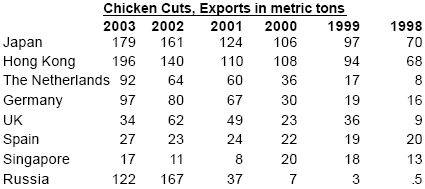



International Egg and Poultry Review
By the USDA's Agricultural Marketing Service - This is a weekly report looking at international developments concerning the poultry industry, this week looking at the growth of Brazils poultry industry.
Brazil
Brazil’s poultry industry has grown dramatically over the past few years.
Broiler production went from 2.36 million metric tons (MMT) in 1990 to
5.98 MMT in 2000. For the first 11 months of 2004, production totaled
7.62 MMT. In 2005, broiler production is forecast at 8.62 MMT. Turkey
production has more than doubled since 1998. Production grew from
107,000 MT in 1998 to 220,000 MT in 2004 and is forecast at 250,000
MT in 2005.

Brazil is able to produce a competitively priced product for the world
market. The poultry industry is vertically integrated and competitive in
genetics, technology and marketing. Labor and feed costs are relatively
low. Brazil's production costs for whole eviserated chicken are
estimated to be the lowest of any major supplier at 1.37 Real/kg
(US$0.48/kg).
Exports were strong in 2004, in part due to marketing promotions, a
favorable exchange rate, and disease problems in countries that were
major competitors. Much of Brazil's chicken is cut by hand rather than
by machine, resulting in a better appearance.
From December 2003 to November 2004, Brazil poultry exports grew
38 percent in value and 25 percent in volume when compared to December
2002-November 2003. Brazil's focus has changed from exporting
whole chickens to exporting higher value branded consumer
ready products. In 1998, 51 percent of chicken exports were whole
chickens, 47 percent were chicken cuts and 2 percent were processed
chicken. Those percentages changed to 41 percent whole chicken, 57
percent chicken cuts and 2 percent processed by 2003.

Brazil's top export markets for whole birds (by volume) in 1998 were
Saudi Arabia, Argentina, UAE and Kuwait. For chicken cuts, the top
markets were Japan, Hong Kong, Spain, Germany and Singapore.

Argentina filed dumping charges against Brazil in 1997. On July 21,
2000 anti-dumping measures were imposed for a three year period.

Brazil's exports to Russia surged in 2002 due to Russia's bans on U.S.
poultry. Import licenses were halted in late February 2002 and on March
1, 2002, Russia formally banned U.S. poultry imports, citing safety concerns.
The U.S. share fell from 79 percent in the first half of 2001 to 59
percent in the first half of 2002. Brazil's exports to Russia fell in 2003
after Russia imposed a quota system, limiting the volume of poultry
Brazil could export to Russia.
Sources: USDA/FAS, Brazil's Ministry of Agriculture, World Trade Organization,
news wires
Highly Pathogenic Avian Influenza Update
Cases of highly pathogenic avian influenza (HPAI) continue to occur in
some Asian countries. Thailand and Vietnam have both reported recent
occurences of HPAI.
The state of Kelantan in Pensinsular Malaysia is no longer considered
an HPAI-infected zone. Culling and disinfection were completed on
November 22, 2004 and no new cases have been detected since that
date.
Source: OIE
To view the full report, including tables please click here
Source: USDA's Agricultural Marketing Service - 20th January 2005








